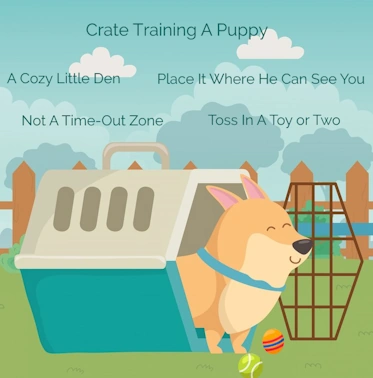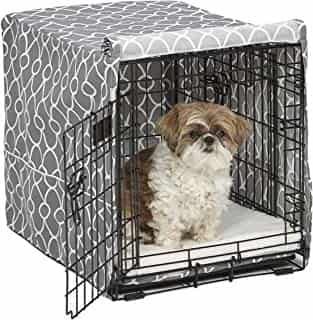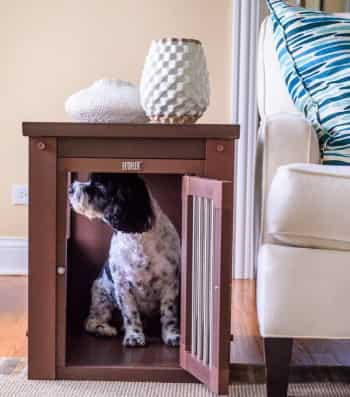Crate Training A Puppy
Fast, Easy And Lasting!
Professionals recommend crate training a puppy
because it works!
Got a new puppy who’s keeping you up at night with those little accidents? Don’t worry, you’re not alone! Crate training can be the answer you’ve been looking for to make both of your lives easier.

Are you looking for a low stress way to handle this?
Then you'll be glad to know that crate training a puppy is a method that
will meet your needs in more ways than one.
And it's the approach most
widely recommended by professional trainers simply because the process
has proven to be successful in getting the job done in the shortest
amount of time!
Here's something else - crate training almost magically modifies the
other areas of dog behavior that you want to correct. And contrary to
what some people may think, the end result is a happier pet that feels
more secure in his world.

However, here are some important things to know...
Top Tips for Successful Crate Training
Here’s the secret to crate training a puppy: start early! I know, it sounds like a lot of work, but trust me, getting your pup comfy with their crate right away will save you both a ton of headaches down the road.
Puppies are little sponges, and they pick up on things quickly—especially when you introduce the crate early on. If you act fast, the crate will soon feel like their cozy little den.
While the crate will mainly be used during the
early months of a pup's life for house training and to keep him safe
from investigating potential hazards around the house, it will later
prove itself invaluable for other purposes, as we shall see.
But the main thing to keep in mind, is that a puppy will have a much
easier time growing up in a loving home with owners who take time to
teach him the social skills he needs.
Learning the rules benefits a puppy by preventing the endless scolding that results when he has to learn on his own through trial and error. Besides which, it's just plain unfair to give a dog free rein in the house and not expect trouble!
Why Crate Training Is a Game Changer
Once you see that your pup has reached the stage where he totally
accepts the crate as his own special place and happily uses it, you will
soon come to realize that it has many other convenient uses.
While I certainly do not advocate that a dog be left in a crate for
prolonged periods, there are times when its use will be advantageous to
both you and your pet.
These are occasions when stress might be a
factor, such as car travel, visits to the vet or groomer, overnight
medical treatment etc. Plus it can be used as part of a process to help
pets overcome separation anxiety.
Also, if you ever need to board your dog, or transport him after an
injury, he will feel safer if he has become accustomed to being in the
confined space of a crate.
Crate Training Supplies You Can't Skip
Crates come in several different types including, plastic, wire, wood and fabric so you can select the best choice for your needs and whether you want to opt for decorative or practical, or both!
- The important first step is choosing the right size so you need to know the size your puppy will become when full grown. No problem if your pup is a purebred, but a little trickier if a mixed breed. A DNA test could help if it's important for you to know.
- Decide if you intend to use the crate for travel, which calls for a plastic crate, or just for house training?
My suggestion is that you get a wire adjustable type of crate that can be expanded as your puppy grows. These come with divider panels so you can make the crate whatever size is needed at the time.
Plastic crates have the advantage of being easier to clean and they are quite affordable, but you will have to buy replacements as your pet grows.
I don't recommend fabric crates for potty training for the reason that puppies like to chew and cleaning is more difficult and time consuming. Plus they are easy to collapse if your pup gets rowdy!
The main point, while potty training, is to keep the space cozy and adequate, but not big enough for him to soil in it and still be able to distance himself from his mess.
If you get a crate with more than one door, just use the same one while training to avoid confusing your pup.
For a fully grown dog, select one with sufficient room for him to stand up, lie down and turn around in.
Tip: wire crates are good for dogs that
like to chew everything! Plastic is needed to meet airline travel
requirements.
Include a nice comfy bed inside the crate. Since dogs and puppies enjoy the nearness of you and have an incredible
sense of smell, a bed that reminds them of you will be ever so comforting to them. See how to make this simple and
easy kind of dog bed here.
A few safe toys, water bowl and some treats to use during training.
When it comes to the actual steps of crate training a puppy, you can read all about the process we recommend here:
puppy house training.
Your Guide to Crate Training: Where to Start
It will likely take a bit of subterfuge at the beginning to get your puppy or new dog interested in the crate.
Don't worry, just give him a bit of time to explore it at his own pace. Some things that will help him see the crate as a positive place to check out and speed up its actual use are:
- Leaving the door open as an invitation, then closing it after putting a treat inside.
- Make that dog bed we talked about earlier - your scent will be reassuring. Or, in its place perhaps an old sweat shirt of yours.
- Give your puppy a treat or toy when he chooses to go in the crate along with substantial praise.
- Keep the crate in the main part of the house where he can see what's going on.
- At mealtimes, place his food bowl near the crate. Sometimes, if pets show prolonged resistance to the crate, food can be placed in it for a while.
When your puppy first starts using the crate, leave the door open until you feel he has accepted this new environment, then start closing it for short periods of time.
Let him out fairly frequently to begin with to ensure he doesn't become fearful - remember you want him to think of this space as a safe haven.
Pro Tips for Crate Training Success
One thing I can't stress enough: don’t use the crate as punishment. I know it’s tempting when they’ve chewed your favorite shoes, but the crate should be their safe space, not a time-out zone.
They need to love going in there! Using it as a reprimand, will just sabotage its use for many other convenient purposes.
Time in the crate should not be excessive. For example, it would not be logical to expect a dog to cross its
legs for five hours waiting to empty its bladder. Plus, long periods or confinement are just not fair to a pet.
Dogs are naturally clean animals and do not like to soil their dens or sleeping quarters. In the wild, a dog or puppy
would leave the den to relieve itself outside.
In your home, the crate becomes your puppy's den where he will spend short amounts of time between other activities: mealtimes, play times and visits outside to eliminate.
As your puppy’s bladder gets stronger, you can start to increase crate time. But remember—no long stretches at first! Start small, and work up from there.


